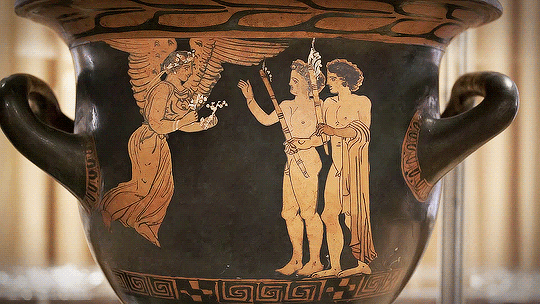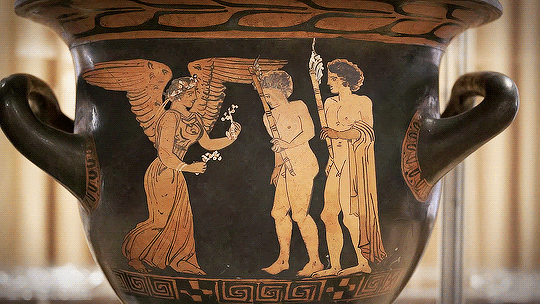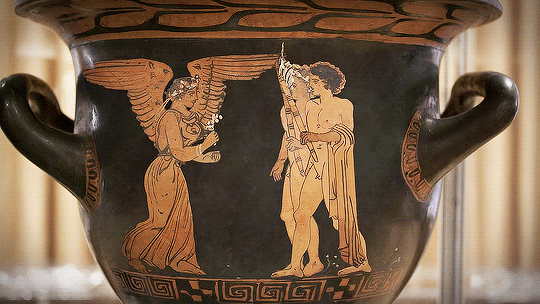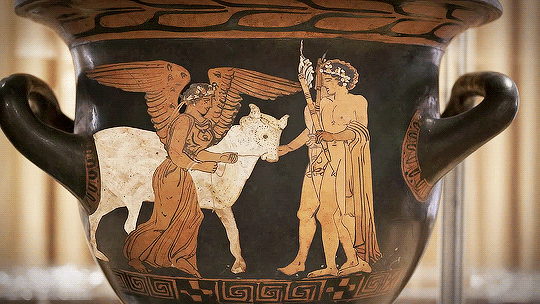Text

A Greek Epinetron, a ceramic cover for the knees used by women so that their clothing would not be spoiled while weaving. Typically offered as a wedding gift, it was often taken to a woman's grave. 425-420 BC. National Museum, Athens.
The epinetron (Greek: ἐπίνητρον, pl.: epinetra, ἐπίνητρα; "distaff"); Beazley also called them onoi, sg.: onos) was a shape of Attic pottery worn on the thighs of women during the preparation of wool, not unlike a thimble for the thigh.[1] Decorated epinetra were placed on the graves of unmarried girls, or dedicated at temples of female deities.[citation needed]
Because of the strong association between wool-working and the Ancient Greek ideal of women and wives—as in the case of Penelope weaving in the Odyssey—it is a shape associated with the wedding.[2]
The theme of its decoration tended to be related to its use. The top surface was often incised to make it rough in order to rub the wool fibers. There was often a female head placed at the closed end, where the knee was covered. Epinetra were often decorated, sometimes depicting black figure Amazon women, as in the case of an epinetron painted by the Sappho painter between 500 and 490 BCE.[3]

The base of an epinetron from Athens, depicting a lion and a pegasus


terps: Epinetron” (επίνητρον) is a ceramic thigh protector that women in Ancient Greece used while spinning wool on their thighs. Penelope is usually pictured with one so it is associated with an activity you do while waiting. For Ulysses to come back, for the crisis to end. [...] I made this epinetron during the lockdown and sculpting it on my thigh, working on top of it for hours, I felt that I replicated the work of the women before me. The “spinning women” as they were called by male archaeologists, who perceived them as unethical because they were working.
6K notes
·
View notes
Photo

Let’s talk keys. Hekate as the Keybearer gets a lot of offerings of modern keys, skeleton keys, and I have those too, but these are keys of the variety that the ancient world would’ve recognized. The teeth on the hooked end moved the tumblers and allowed the lock to turn. They were easily overcome, most of them. They had a variety of shapes, materials, and sizes, with temple keys being heavy ceremonial objects. Last year, I commissioned a friend I trust and adore, to make these simple household keys for my shrine, and they’re among my most prized pieces.
96 notes
·
View notes
Photo




The Procession
Panoply Vase Animation Project
9K notes
·
View notes
Text
Epithet: Skylakagetis
Leader of Dogs.
PGM IV 2711-2730
Come, giant Hekate, Dione’s guard, O Persia, Baubo Phroune, dart-shooter, Unconquered, Lydian, the one untamed, Sired nobly, torchbearing guide, who bends down Proud necks, Kore, hear, you who’ve parted gates of steel unbreakable. O Artemis, Who, too, were once protectress, mighty one, Mistress who burst forth from the earth, dog-leader, All-tamer, crossroad goddess, triple-headed, Bringer of light, august/virgin, I call you Fawn slayer, crafty, O infernal one, And many-formed, Come, Hekate, goddess Of three ways, who with your fire-breathing phantoms Have been allotted dreaded roads and harsh Enchantments.
And then we see again in PGM IV 2811-2228: “…Your ankle is wolf-shaped, fierce dogs are dear to you, wherefore they call you Hekate…”

For the Greeks, dogs aided the hunt, guarded crops and livestock, and were even kept as pets. For pets they seem to prefer a small lap-dog. We find reliefs with dogs on tombs and vases, and in murals, where they wait at their human’s feet, and sometimes under tables at dinner. Images survive which show dogs and children at play or lounging at home together. There are graves where the dog has been buried with his human, and offerings of dogs were given to some Chthonic Gods.
Brimo, a goddess in Her own right, and conflated with Hekate in PGM IV. 2270 and PGM IV. 22607, was also called dog-leader.
We know from both plays and from the surviving spells turned toward Hekate’s attention that Her worship included the sacrifice of dogs, particularly black puppies. These offerings seem to have a purificatory power.
By the Roman era, Hekate is sometimes represented with the head of a dog. Jupiter too, was sometimes called dog-leader, Cynegetes in this case, and was credited with teaching Arcadia to drive away feral packs. Dogs were said to guard the Roman temples, and were sacrificed at Lupercalia and other festivals.
Hekate’s hounds in particular are described as black and large, which puts them in the same category as several monstrous canines known to the world. In the Hellenistic era, they were understood to be the souls of the Restless Dead which haunt the crossroads with their Mistress. Lucian offers a chilling description of Hekate and her hounds. She is described as vast and serpentine, with snakes for hair and a serpent tail, and her dogs were larger “than Indian elephants” and shaggy, matted, and black. Here she carries a torch and a sword. She opens a chasm and leaps down into Tartarus.
Descriptions of the Deipna often include the warning that one will hear the call of Her dogs when the meal is laid at the three-way crossroad, along with an injunction not to look back as you leave.
Most strikingly is the graveyard at Poggio Gramignano in Teverina, Italy. This is an infant graveyard, full of small children, and dogs. The archaeologists who have studied the site suspect that some tragedy struck, because all the graves date to the middle of the fifth century CE. The dog burials are mostly puppies, and have their own separate burials from the children. Some of the canid skeletons show signs of a traumatic death. Scholars likewise suspect that the dogs were sacrificed to Hekate, in light of her history with puppy and dog sacrifice and her canine characteristics. Plutarch describes the sacrifice of puppies as involving rubbing the puppy against the inflicted and sacrificing it to Hekate, suggesting that the puppy played a role as scapegoat. As a result, some scholars speculate that this graveyard’s dog graves are evidence of evil-averting exercises dedicated to Hekate after some sort of plague, in hopes of halting the illness.

Dogs are often associated with Goddesses of birth, and with some Healing Gods. They are also associated with Ares, who received dog-sacrifices.
Ultimately, their association with both the haunt of the Restless Dead and their role as guardians fits well with the dog’s capacity as guardians as well as their capability for viciousness.
This dichotomy also suits the Goddess that is both Chthonic and Ouranic, of heaven and earth. Hekate is benevolent and kindly, and terrible and grim. They share the potential for both natures. It seems natural for Hekate to take the dogs under her wing.
Today, dog sacrifice is frowned upon, both legally and ethically, but there are many of Hekate’s devotees who take time to care for dogs, or to donate time and money to rescues, all in Her name. I myself tithe money each month and then bundle the donations to a charity for dogs. I have volunteered in the past, walking and caring for various animals, and dedicated the act to Her, even praying to Her on walks with the dogs. It all made for a deeply inspirational and rewarding practice.
Sources:
Theoi.com The LSJ lsj.translatum.gr
Bell, John. Bell’s New Pantheon: or, Historical Dictionary of the Gods, Demi-gods, Heroes, and Fabulous Personages of Antiquity: Also, of the Images and Idols Adored in the Pagan World…Bell, 1790. Betz, Hans Dieter. The Greek Magical Papyri in Translation, including the Demotic Spells, vol. 1, Univ. Chicago, 1992. Brown, Thomas. Biographical Sketches and Authentic Anecdotes of Dogs. Brown, 1829. Franklin, Alberta Mildred. The Lupercalia. Columbia, 1921. Harrison, J. R. “Every Dog has its Day,” in New Documents Illustrating Early Christianity: Vol. 10: Greek and Other Inscriptions and Papyri Published 1988-1992. Edited by S.R. Llewellyn et al. Eerdmans, 2012. Pp. 126-135. Heath, Malcolm, et al. Religion and Belief: A Moral Landscape. Cambridge, 2014. International Council for Archaeozoology. Dogs and People in Social, Working, Economic or Symbolic Interaction, Oxbow, 2006. Johnston, Sarah Iles. Hekate Soteira. Oxford, 1990. ————–. Restless Dead, Univ. California, 2013. —————. Note 12 on “The Tablets from Pherae,” in Ritual Texts for the Afterlife: Orpheus and the Bacchic Gold Tablets, by Fritz Graf and Sarah Iles Johnston, Routledge, 2013. Ogden, Daniel. Drakon: Dragon Myth and Serpent Cult in the Greek and Roman Worlds, Oxford, 2013. ————-. Magic, Witchcraft, and Ghosts in the Greek and Roman Worlds. Oxford, 2009. Ovid. Fastorum libri sex. Trans. By Sir James Frazer. Cambridge, 2015. Soren, David, and Noelle Soren. A Roman Villa and a Late Roman Infant Cemetery, L’Erma di Bretschneider, 1999.
Images: Attributed to the Kleibolos Painter. “Hekate with Dog,” black figure kylix, Archaic period. Via theoi.com.
Funerary loculus to Antigona and Aristopolis, found in the Hadra necropolis in Alexandria, Egypt. Limestone. Now in the Louvre. C. 300 BCE. via wikicommons: https://commons.wikimedia.org/wiki/File:Funerary_loculus_slab_with_names_of_Antigona_and_Aristopolis_(c._300%E2%80%93250_BCE),_Alexandria,_Egypt_-_20070817.jpg
55 notes
·
View notes
Text
In Roman mythology, Dea Tacita ("the silent goddess") also known as Dea Muta or Muta Tacita, was a goddess of the dead.[1][2][3] Ovid's Fasti includes a passage describing a rite propitiating Dea Tacita in order to "seal up hostile mouths / and unfriendly tongue" at Feralia on 21 February.[4][5] Dea Tacita is the same as the naiad Larunda.[6][7] According to Ovid this occurred because Dea Tacita had her tongue ripped off by Jupiter. Jupiter was angry with her because she told the nymph Juturna to flee from him because he planned to rape her.[8] In this guise, Dea Tacita was worshipped at a festival called Larentalia on 23 December.[9] Goddesses Mutae Tacitae were invoked to destroy a hated person: in an inscription from Cambodunum in Raetia, someone asks "ut mutus sit Quartus" and "erret fugiens ut mus"[10] ("that Quartus be mute" and that he "wander, fleeing, like a mouse").[11]Plutarch, who described Tacita as a Muse, states that Numa Pompilius credited Tacita for his oracular insight and taught the Romans to worship her.[12]
Larunda (also Larunde, Laranda, Lara) was a naiad nymph, daughter of the river Almo and mother of the Lares Compitalici, guardians of the crossroads and the city of Rome. In Ovid's Fasti she is named Lara.[1]
Myth
See also: Mother of the Lares
The only known mythography attached to Larunda is little, late and poetic, in Ovid's Fasti. Ovid names her Lara, an excessively loquacious river-nymph, daughter of the river-god Almo. Ignoring parental advice to curb her tongue, she betrays Jupiter's secret, adulterous affair with the nymph Juturna, wife of Janus, to his own wife, Juno. Jupiter wrenches out Lara's tongue and orders Mercury, psychopomp and god of boundaries and transitions, to conduct her to the "infernal marshes" of Avernus, the gateway to the Underworld, the dismal realm of Pluto. Along the way, Mercury rapes her, despite her pleading glances. Mute (Latin muta) and silent (Latin tacita), she thus conceives the divine Lares, twin guardians of crossroads and the city of Rome.[1]
Larunda's original name, according to Ovid, was "Lala", imitative of her garulous speech. Robbed of the power of speech, she is likely identical with Muta "the mute one" and Tacita "the silent one": nymphs, minor goddesses or aspects of a single deity with semantic connections to the Lares and perhaps the Lemures as darker forms of Lares.[2][3]
Cult
Ovid expounds this myth of Lara and Mercury in the context the festival of Feralia on February 21,[1] and an informal, secretive women's folk-cult at the same festival, invoking Tacita ("the silent goddess"). The rite is led by "an old hag" who holds seven black beans in her mouth; it has similarities to the exorcism of hostile, vagrant spirits at the Lemuria festival, but is completed when a fish-head is sewn up to "bind hostile tongues to silence". Lara/Larunda is also sometimes associated with Acca Larentia whose feast day was the Larentalia on December 23.[4]
The Mother of the Lares (Latin Mater Larum) has been identified with any of several minor Roman deities. She appears twice in the records of the Arval Brethren as Mater Larum, elsewhere as Mania and Larunda. Ovid calls her Lara, Muta (the speechless one) and Tacita (the silent one).
Lares (/ˈlɛəriːz, ˈleɪriːz/ LAIR-eez, LAY-reez,[1] Latin: [ˈlareːs]; archaic lasēs, singular lar) were guardian deities in ancient Roman religion. Their origin is uncertain; they may have been hero-ancestors, guardians of the hearth, fields, boundaries, or fruitfulness, or an amalgam of these.
Lares were believed to observe, protect, and influence all that happened within the boundaries of their location or function. The statues of domestic Lares were placed at the table during family meals; their presence, cult, and blessing seem to have been required at all important family events.
Roman writers sometimes identify or conflate them with ancestor-deities, domestic Penates, and the hearth.
Because of these associations, Lares are sometimes categorised as household gods, but some had much broader domains. Roadways, seaways, agriculture, livestock, towns, cities, the state, and its military were all under the protection of their particular Lar or Lares. Those who protected local neighbourhoods (vici) were housed in the crossroad shrines (Compitalia), which served as a focus for the religious, social, and political lives of their local, overwhelmingly plebeian communities. Their cult officials included freedmen and slaves, otherwise excluded by status or property qualifications from most administrative and religious offices.
Compared to Rome's major deities, Lares had limited scope and potency, but archaeological and literary evidence attests to their central role in Roman identity and religious life. By analogy, a homeward-bound Roman could be described as returning ad Larem (to the Lar). Despite official bans on non-Christian cults from the late fourth century AD onwards, unofficial cults to Lares persisted until at least the early fifth century AD.
2 notes
·
View notes
Text

Paris Street Style
243 notes
·
View notes
Text

I’ve been listening to “Blood Moon” by Saint Sister a lot this season and it inspired this piece of a spooky Minoan Artemis dancing in the woods.
2K notes
·
View notes
Text

'Winter’s Night with Cabins'. Svend Rasmussen Svendsen. 1910.
12K notes
·
View notes
Text

Hail Hekáte, Enodia, Goddess of All!
156 notes
·
View notes
Text

Harvest Moon last night so I guess it really is autumn now 🍂
8K notes
·
View notes
Text

Zeus by Romain de Tirtoff (“Erté”) (1981)
3K notes
·
View notes
Text

invented a game called “I throw dice at the cat”
81K notes
·
View notes
Text

Even the crows have been playing in the snow, making their own snow angels. This was the best of a series I found.
26K notes
·
View notes


